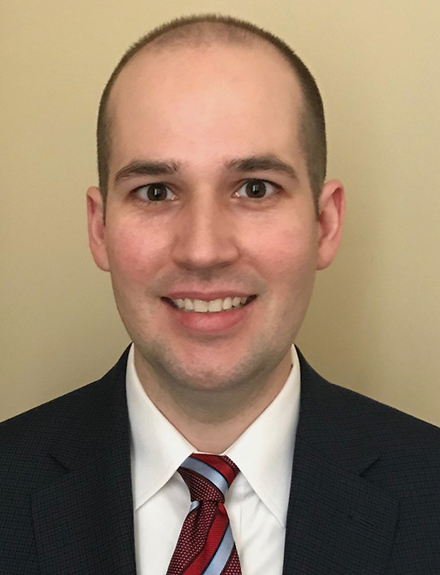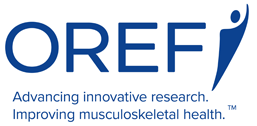

Christopher D. Collier, MD
Resident Clinician Scientist Grant
Research Topic
Developed and validated a drug-screening platform for progression of osteosarcoma micrometastases, then screened 114 FDA-approved anticancer drugs.
Patient Impact
A new use for drugs, which are already approved by the FDA, shown to have the potential to improve outcomes in osteosarcoma without the costs usually associated with drug discovery
Better Answers for Osteosarcoma Patients
OREF grant recipient on the way to short- and long-term answers
Sharon Johnson, OREF contributing writer
Osteosarcoma is the diagnosis no one wants to give—or hear. The disease is responsible for the majority of deaths due to bone tumors; it is the eighth most common cancer and third most common cause of cancer deaths in adolescents and young adults.1 Although many treatment options are available, only about 25 percent of patients with metastatic osteosarcoma live more than five years after diagnosis.2
As a relatively rare disease, osteosarcoma has not garnered the research support needed to find more effective treatments. For similar reasons, few Food and Drug Administration (FDA)-approved medications have been evaluated in osteosarcoma.
Chemotherapy is the mainstay for osteosarcoma treatment, but the chemotherapy regimen has not changed for 40 years and as a result, neither has survival. Considering this and the high genomic complexity of the disease, osteosarcoma seems ripe for research that would yield a personalized-medicine treatment. However, that timeline is much longer than most osteosarcoma patients have.
Advancing care with support from OREF
During his second year of residency at Case Western Reserve University, Christopher D. Collier, MD, investigated a new way to screen FDA-approved medications for osteosarcoma. An Orthopaedic Research and Education Foundation (OREF) Resident Clinician Scientist Grant, made possible by the John T. Hocker Charitable Foundation, supported the research. The goal of Dr. Collier’s study was to find one or more drugs already in use that might be effective against osteosarcoma and repurposed to improve and/or prolong patients’ lives.
With more than 100 FDA-approved cancer drugs available, prospects for finding at least one good candidate to repurpose appeared good. Still, the ideal cell-based assay for screening the drugs would need to mimic lung micrometastases—no small challenge, but a certainly a worthy one.
“The majority of osteosarcoma patients are teenagers, whose biggest challenge of the year should be who to date, what sport to play, or where to go for college,” Dr. Collier said. Instead, they are faced with a terrifying and debilitating diagnosis that impacts everything. As surgeons, we are often able to remove the primary tumor without amputation, but what ultimately saves the lives of these patients is chemotherapy. This is because 80% of patients without evidence of metastatic disease on imaging likely harbor subclinical micrometastases in their lungs. We cannot see it, but the cancer is there and before chemotherapy these patients would not survive. Current chemotherapy saves 60-70% of these patients but the available drugs for osteosarcoma have not changed since the 1970s. To improve the outcome for the other 30-40% of kids, we need better options.” Targeting the metastatic progression of osteosarcoma with new agents would give those not responsive to traditional chemotherapy a better chance.
Evaluating 114 drugs using tandem disease models
Dr. Collier’s investigation used three highly metastatic human osteosarcoma cell lines in two complementary models of disease to approximate the three-dimensional micrometastasis to patients’ lungs, where osteosarcoma tends to spread.
One disease model utilized multicellular tumor spheroids (MCTSs), which researchers have relied on for more than 40 years for their resemblance to small avascular tumors and micrometastases. The second model Dr. Collier used is a well-described in vivo murine tail vein model of pulmonary metastasis, which preserves the in vivo microenvironment.
Using the MCTS model, Dr. Collier and his research team screened a library of 114 FDA-approved anti-cancer drugs made available to researchers worldwide, free of charge by the National Cancer Institute’s Development Therapeutics Program. Prior to Dr. Collier’s study, 50 of the 114 drugs in the library had never been evaluated for use in osteosarcoma.
Encouraging results prompt further study
Thirteen of the 114 drugs tested in the MCTS model showed promise against the metastatic progression of osteosarcoma. Dr. Collier and his team further described these 13 drugs and investigated the effect of them on normal cells and how they performed in combination with methotrexate, doxorubicin, and cisplatin (MAP) chemo therapy, the conventional treatment for osteosarcoma. The team noted synergistic effects of several drugs. These findings were published in the July 2018 issue of Clinical Orthopaedics and Related Research.3
The successful identification of promising drugs in the first part of the study led to a National Institutes of Health R21 Grant, which allowed Dr. Collier and his mentor Dr. Edward Greenfield to adapt the spheroid model to study the best candidates further. Dr. Collier intends to take drugs effective at this stage into more robust in vivo testing, perhaps in a canine model and, eventually, into human clinical trials.
Potential to save lives for generations to come
If successful, Dr. Collier’s research will leapfrog the time and expense of traditional drug discovery and accelerate access to novel therapeutics for treating osteosarcoma patients. Given the potential to change the standard of care and improve survival rates, Dr. Collier is fulfilling his career goal to help patients heal and also make a lasting difference as a clinician scientist.
“OREF provides a tremendous opportunity for, at least in my case, young orthopaedic surgeons in training to explore their interests and determine how they see themselves practicing orthopaedic surgery in the future,” Dr. Collier said. “For me, a clinician scientist is someone who is not only devoted to the care of their own patients, but someone who is driven by scientific curiosity to improve the lives of all patients, and to have a lasting impact that goes on for generations to come.”
Dr. Collier’s OREF-supported research appears to be an excellent opportunity to do just that.
References
1.Ottaviani, G., & Jaffe, N. (2010). The epidemiology of osteosarcoma. Pediatric and Adolescent Osteosarcoma (pp. 3–13). Springer US.
2.PosthumaDeBoer, J., Witlox, M. A., Kaspers, G. J. L., & Van Royen, B. J. (2011). Molecular alterations as target for therapy in metastatic osteosarcoma: a review of literature. Clinical & experimental metastasis, 28(5), 493–503.
3.Collier, Christopher D., et al. “Micrometastatic Drug Screening Platform Shows Heterogeneous Response to MAP Chemotherapy in Osteosarcoma Cell Lines:” Clinical Orthopaedics and Related Research, vol. 476, no. 7, July 2018, pp. 1400–11. DOI.org (Crossref), doi:10.1007/s11999.0000000000000059.
